Piano sheet music is the written notation of a song that can be played on a keyboard or piano. It includes information such as which notes should be played, when they should be played, and how loud or soft each note should be.
Understanding sheet music is an essential part of learning piano and offers many advantages. It gives you a deeper understanding of music theory, advances your technical abilities and allows you to perform any new piece of music.
In this step-by-step guide, we’ll take you through the basics of reading sheet music so you can play all of your favorite songs on the piano. We’ll cover everything from basic note names and finger notation, up to more advanced concepts like key signatures and dynamics.

| Keys On The Piano
| Keys On The Piano
When learning piano sheet music, the first thing to understand is the different keys on the piano. Piano keys are named in alphabetical order, specifically from A to G.
The piano keyboard is made up of white and black keys, which represent specific musical tones. The white keys represent the musical tones A, B, C, D, E, F, and G while the black keys represent half-step intervals between these notes known as sharps and flats.
The seven white keys and five black keys make up a total of 12 total different notes, which is called an octave.
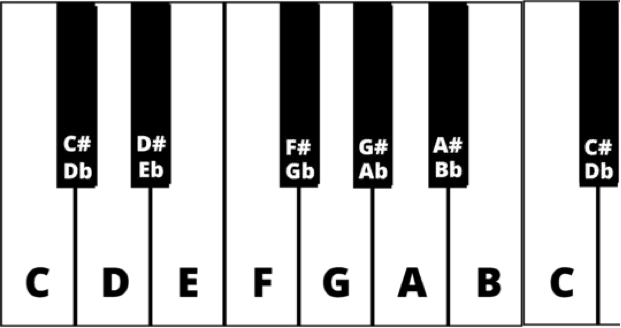
| Finger Notation
Understanding finger notation is an important step in learning to play the piano. It’s a way of showing which fingers to use on which keys, and it can be very helpful for beginners. The notation is based on the shape of the hand, with each finger labeled from 1 to 5. On both hands, the thumb is number 1 while the pinky finger is numbered 5.

In beginner sheet music, finger numbers are written alongside the corresponding notes to help beginner pianists learn how to place their fingers correctly. For more advanced pieces, the fingering is only shown in technical areas or where there is an abrupt switch in the key being used. Learning finger notation will help you to play more smoothly.

| Treble & Bass Clefs
The next thing to learn after understanding how the keys of a piano are displayed in sheet music. Piano sheet music is written on musical staves which are sets of lines and spaces on which notes are written. Each line and space corresponds to a note, as seen in the image below.
The staves are then divided into the treble and bass clef. The treble clef represents the higher notes, and its notes are usually played by the right hand. The other is the bass clef. Its notes are lower and are played by the left hand.

Ledger Lines
A ledger line is a line that is used to notate notes that are higher or lower than the standard range of the staff. Ledger lines are used to extend the staff and make it easier for pianists to identify notes that fall outside of the standard lines of the treble and bass clefs.
Mnemonics
If you’re having difficulty memorizing which line or space represents which note, you can use mnemonics to help you remember the notes more quickly.
A common mnemonic for the treble clef is “FACE equals Space” or F-A-C-E; these are the notes represented by the spaces in between the lines. To help you remember the notes on the lines of the treble clef, try using the mnemonic Every-Good-Boy-Deserves-Fruit or E-G-B-D-F.
For the bass clef, a common mnemonic is All-Cows-Eat-Grass or A-C-E-G to represent the notes in the spaces. To help you remember the notes on the lines of the bass clef, try using the mnemonic Gum-Boots-Don’t-Fit-Ants or G-B-D-F-A.

| Accidentals
Accidentals are symbols that can be added to a note to change its pitch up or down. They are commonly known as ‘sharps’ and ‘flats’ and they raise or lower the pitch of a note by one semitone (half-step).
The sharp symbol (♯) raises a note by one semitone, while the flat symbol (♭) lowers it by one semitone. In beginner piano sheet music, notes with sharps or flats usually indicate that you are to play a black key.
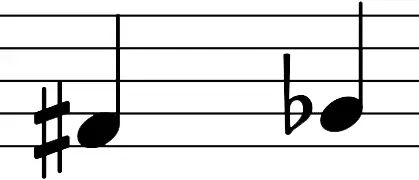
| Bars
In music theory, a bar (or measure) is a segment of time that can be broken down into beats. Bars are like the building blocks of a piece of music. The beginning of each new bar is indicated by a vertical line called a barline.

| Notation
The appearance of a note on a musical staff indicates the length of time a pianist should sound a particular pitch. Using Western notation, there are five main note names that you should know as a beginner. These notations are the semibreve, minim, crotchet, quaver, and semi-quaver.
The semibreve (also called a whole note), is worth four beats. It produces other notes by halving its value: the minim (or half note) is worth two beats and the crotchet (or quarter note) equals one beat. This pattern of halving continues until you reach the quaver (or eighth note), which counts for a quarter of a beat and the semi-quaver (or sixteenth note) which equals a quarter of a beat.
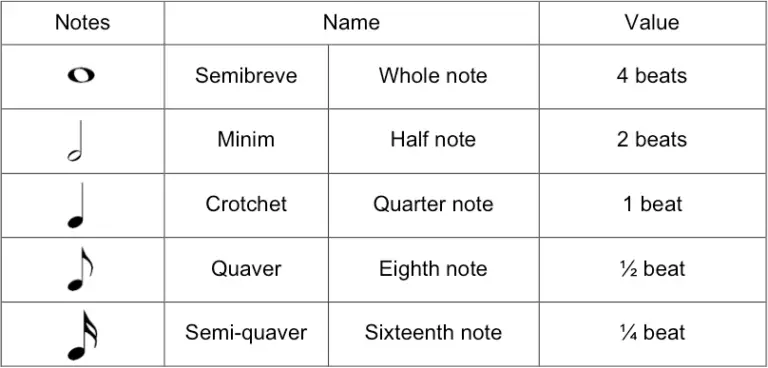
| Rests
A rest indicates that nothing is to be played for a certain length of time. Rest can be used to mark the end of a section, or it can be used to create space between notes. Just like notes, there are different rest symbols that indicate varying rhythmic values. Rests are used in conjunction with notes to make up the required amount of beats in each bar of music.
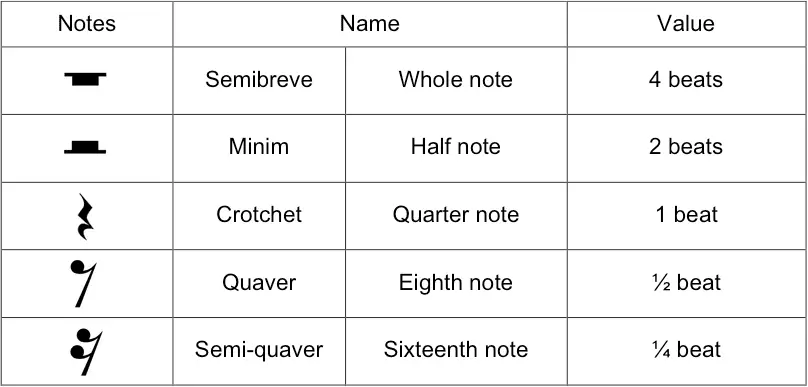
Multi-Bar Rests
Multi-bar rests are just what they sound like: they are rests that last more than one bar. Multi-bar rests are used in music theory to indicate that a certain number of bars should remain silent. They are represented by a thick, horizontal line in the middle of the staff with a number on top indicating how many bars the rest should go for.
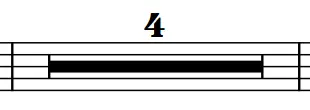
| Time Signatures
The time signature tells you how many beats are in a bar and what type of note is equal to one beat. A time signature is made up of two numbers: one above the middle line of the staff and one below. The time signature is displayed at the beginning of the first bar of a piece of music. More than 90% of popular songs written in the last century are in 4/4 time.

Top Number:
The top number of a time signature indicates how many beats are in a bar. In 4/4 time, for example, there are four beats in each bar. This means that if you count the beats out loud while listening to a song in 4/4, after four counts, you will reach the start of a new bar.
Bottom Number:
The bottom number indicates what type of note is equal to one beat. A ‘4’ on the bottom means a quarter note (or crotchet) is equal to one beat. As a beginner, this will be the case for most of the music you learn. An ‘8’ on the bottom means an eighth note (or quaver) is equal to one beat. For example, the notes in a single bar of a song in 4/4 will add up to four beats. However, the notes in a single bar of a song in 4/8 will add up to two beats.
| Dotted Notes
A dotted note means that you hold the note for an additional half of its value. For example, a dotted minim (or half note) would last for three beats instead of two.
Dotted notes are used to make a note last longer than its original value and to add variation in rhythm. They can also be used to fill gaps in melodies where there would normally be rests or silence between notes.
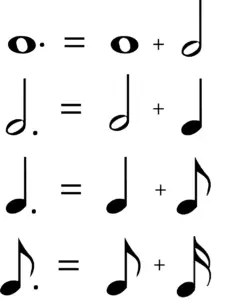
| Dynamics
Dynamics are used to describe the loudness or softness of a song. They are used to create contrast in a piece of music or make certain parts stand out more than others. A song’s dynamics are always stated at the beginning of a piece but can also change throughout a song.
The symbols used to indicate dynamics are called dynamic markings. The letter f is an abbreviation of the Italian word forté which means loud. On the other hand, the letter p is an abbreviation of the Italian word piano which means quiet. The m simply stands for moderately.
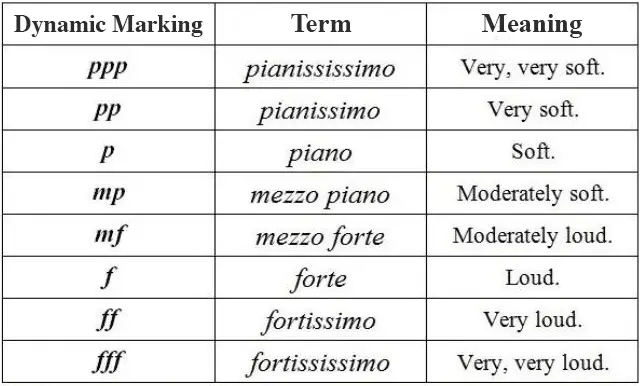
Crescendos & Decrescendos:
Crescendos and decrescendos are two important musical terms that describe the gradual increase or decrease in volume of a musical piece. A crescendo is a gradual increase in volume while a decrescendo is a gradual decrease in volume. Both crescendos and decrescendos can be used as transitions between sections of music, but they can also be used to create tension or excitement within the music itself.

Accents:
An accent is a stronger attack or emphasis placed on a particular note or chord. Accents are what gives a song its character—they help to add variation or intensity to a piece. An accented note features a greater-than symbol above or below the note.
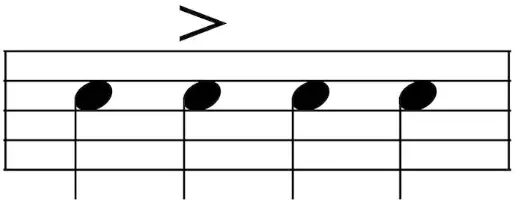
| Conclusion
This forms the foundation for anyone trying to learn to read sheet music. It doesn’t cover everything but once you understand these basics, learning the rest becomes more manageable. It is important to remember that the secret to learning piano is always practice. The more you try to read different pieces of music, the better you’ll become.
Related Posts:
How Long Does It Take To Learn The Piano?
How Much Does A Piano Cost? | The Complete Price Guide
How To Find The Key Of A Song
Want To Know More?
Here at Live Aspects, we have dozens of useful lessons and tutorials created to enhance your music production skills and help speed up the learning process. You can access our huge range of music theory lessons and production tips and tricks here.
